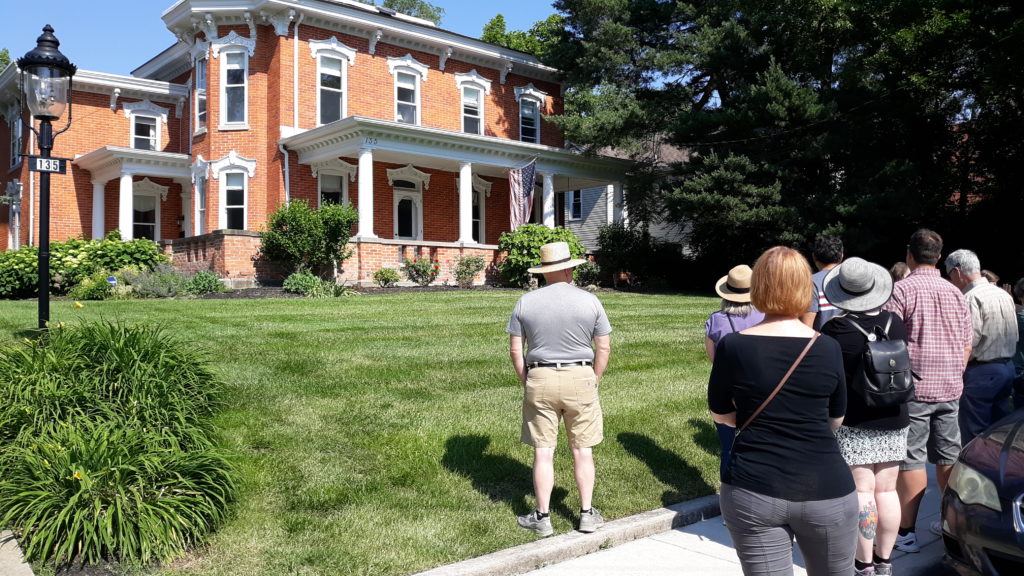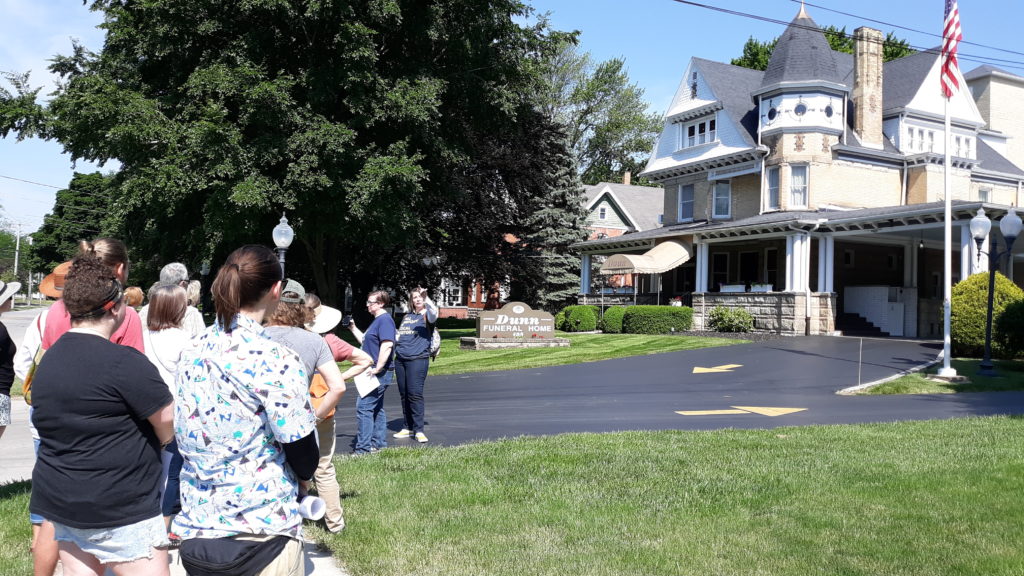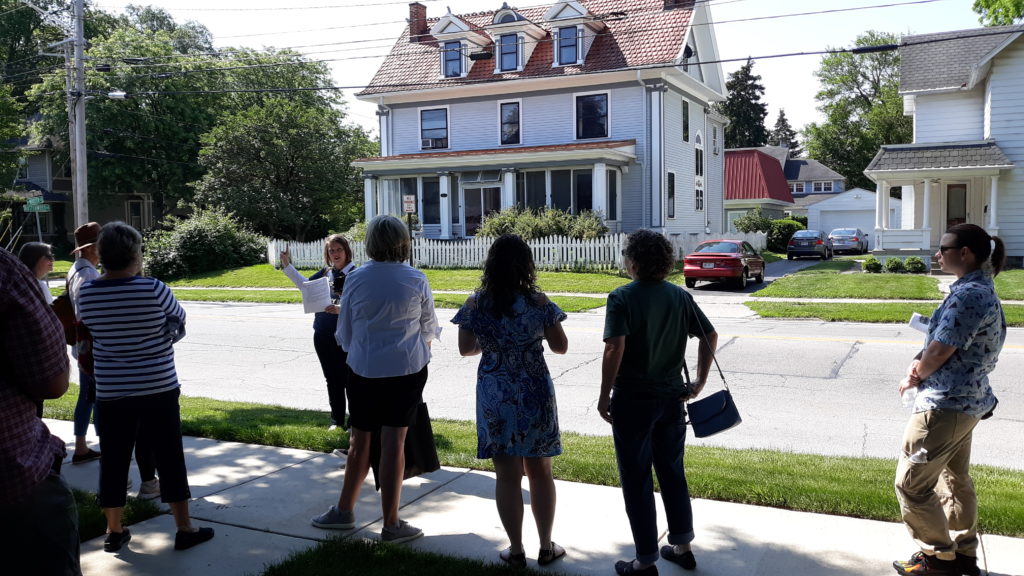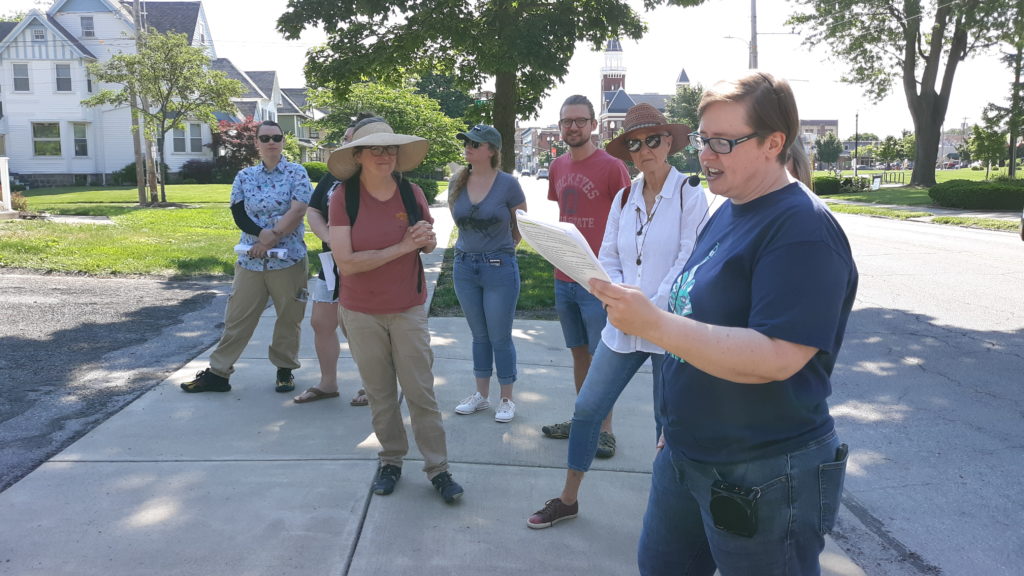By JAN LARSON McLAUGHLIN
BG Independent News
The oil boom era in Bowling Green brought risk takers, hard workers, and just plain lucky men to the city in the late 1800s. It turned gallant Civil War veterans into wealthy citizens, and resulted in beautifully ornate homes on the west edge of the downtown.
On Saturday, a walking tour through the Boomtown area attracted local history buffs and residents curious about the roots of their community. The tour – which was quickly overbooked with a waiting list – was led by Marnie Pratt, local history librarian at Wood County District Public Library, and Kelli Kling, director at the Wood County Museum.
Pratt started by setting the scene for the tour. Bowling Green was a small town of 169 residents when the 1860 census was taken. A decade later, the town had grown to 906 residents.
Then Bowling Green was named the county seat in 1875, and oil was struck in 1885 – causing the city population to explode to 5,000 residents.
While the boomtown era brought wealth, it was still a town of plank sidewalks and dirt streets. On the city payroll was a lamplighter, who was tasked with lighting and extinguishing the street lights each night.

The walking tour headed west from the library, making stops for the participants to admire still grand homes constructed in styles ranging from Italianate, Queen Anne, Gothic, Neo-colonial, and Georgian Revival.
“It’s funny, when you walk you see things you never see when you drive by,” said Wil Roudebush, a member of the city’s Historic Preservation Commission.
Chad Duffy brought his wife, Lorene, 36, on the tour for her birthday. The couple has lived in Bowling Green for three years.
“It’s so fascinating to learn about local history,” he said.
Katelyn Elliott said her family has brushed up on local history, taking part in the recent scavenger hunt downtown, and learning along with their third grader on the school district’s local history curriculum.
“I’m here because of my interest in local history,” she said.
Some participants had close ties to the tour – including Erin Hachtel, who found out that her home at the northeast corner of West Wooster and North Grove streets was part of the tour.
“I didn’t know that. Cool,” Hachtel said as the tour headed toward her Queen Anne style home.
For some, the ties were decades old. Margaret Montague pointed out the West Wooster Street home that was previously a hospital. Her brother was born there in 1943.
A little further down the street was the old Wood County Children’s Home, where Montgague’s father spent part of his childhood. The Gothic style building was home to many children whose parents could not care for them due to deaths, abandonment, abuse, poverty or mental health issues.
“It was like a safety net,” Montague said.
The tour was as much about the people who lived in the Boomtown homes as the historic architecture.
The Carter House, on North Church Street behind the library, was frequently a meeting place for the Shakespeare Round Table group – which still exists today, Pratt said. At one of the women’s meetings in 1911, a fundraiser was launched to establish the first public library.
“We were actually born in that building,” Pratt said.

The Italianate style brick home at 135 N. Grove St. was built around 1878 for Civil War veteran Captain JB Newton. When natural gas was discovered, it created opportunities for the glass industry in Bowling Green, and Newton became director of the Buckeye Glass Co. & the Ohio Flint Glass Co.
This house is supposedly the first house in Bowling Green to have a bathtub, and is also rumored to have had a secret passageway.
“I want to believe it’s there somewhere,” Kling said.
The Queen Anne style home at 226 W. Wooster St., features a variety of colors and texture materials, and a corner-cut double bay window with twin pyramid roofs. It was built around 1889 for another Civil War veteran, James Cunning.
“This was the outskirts of town,” when it was built, Kling said.
Some of the grand homes told stories of bold women during the boom era.
A jeweler and silversmith, Frederic Von Kanel came to Bowling Green in 1877, and opened a store downtown. He died in 1893, but his wife and daughter finished the building of their home at 316 W. Wooster St., and built a large brick storefront downtown and continued his jewelry business.
This was unusual at the time for women to run a large business like this, Pratt said. Historical records stated that “Their success has been almost phenomenal. They have carried on the store in an admirable manner, having largely increased stock, keeping up with latest styles and fancies of the day and have won the admiration and commendation of businessmen throughout the country. They are a living illustration of what women with brains, force of character, and a determined purpose can accomplish in any line to which they devote their energies.”
Mrs. Von Kanel was the sister of Alex Klever, who also worked in the jewelry store. Klever’s specialty was watch repair. When the Von Kanel store was sold, Alex Klever opened Klever’s Jewelry, which operated downtown for many years.
Another house on the route, at 328 W. Wooster St., played a notable role for women in Bowling Green. The Italianate style home with broad overhanging eaves, ornate window frames and decorated cornices, was built in 1878-1881 and purchased by John W. Canary, who was a local merchant and lawyer.
In 1912, a group of women gathered in the home, hosted by Celia Canary. They were joined by a woman named Mecca Marie Varney, who had just given a lecture in the area on women’s right to vote. The Wood County Suffrage Group continued to hold meetings in houses of several other women throughout the city for coming years.

Another Civil War veteran, John Hankey, built his home at 408 W. Wooster St., which is now Dunn Funeral Home. Hankey had been struck with typhoid fever and was discharged from the service in 1864.
Hankey was a true entrepreneur of the oil boom period in Wood County, KIing said.
“He was a risk-taker and he was rewarded handsomely for it. He owned a number of properties downtown, and in fact, one obituary stated that he financed more block buildings downtown than any other single investor,” she said.
Hankey turned around a deteriorating sawing and planing mill, had a hand in glass and oil companies, a bank, machine shop and politics. He was also one of the founders of the Bowling Green Opera House.

Across the street, at 403 W. Wooster St., is the Neo-colonial style built by Thomas Conley in 1902, reminiscent of homes in his hometown of Baltimore, Maryland. Conley was a lawyer, court reporter and law librarian.
The house was eventually passed on to his daughter, Minniebelle Conley, who was the society page editor of the Daily Sentinel for 52 years (1927-1980).
At 333 W. Wooster St. sits a home built in 1896 by another self-made businessman, Albert Royce. He reportedly started by working for 75 cents a day in a chair factory in Toledo. He eventually quit this job and with money he had saved, opened his own grocery store in Bowling Green. He later moved into a larger grain buying/selling business, then into banking/investing.
“Pretty much everything he got into was either a big success or he was at least in the right place at the right time, which was often the case with a lot of these early county residents,” Pratt said. “He was so successful he didn’t need to keep the oil discovered on his land.”
Characteristically colorful like other homes of the Boomtown era, is the home at 327 W. Wooster St. The Queen-Anne style with a three-story octagonal tower, was built for $9,000 in 1892 by Dr. Charles D. Yonker, who was a prominent physician and druggist.
He had a very successful drugstore for many years, then became a successful insurance salesman. The insurance company went through a financial scandal that destroyed the company and the financial security of many associated with it.
Yonker reportedly worried so much about not only his finances but those of the people he had gotten to invest in the company that he suffered a nervous breakdown, and took his life in 1919.
The newspaper described it as one of the largest attended funerals in recent years and quoted one speaker as saying he knew of “no other man who had spent himself for others as had Charley Yonker.”

The Georgian Revival style home with Roman Ionic columns at 323 W. Wooster St., was built in 1904 by Bert Froney, who took over the department store his father started downtown when he died in 1911.
Froney served on city council and was instrumental in establishing a permanent fund to maintain Oak Grove Cemetery. He served on the Board of Trade, which was an organization established to help renew the city after the oil boom. On a more personal level, Bert and his wife were well-known around town for the elaborate costume parties that they hosted.
Next door, at 315 W. Wooster St., sits another Queen Anne style home built in 1892 by George Helfrich. He started as a harness maker, and eventually became publisher of the Wood County Tribune newspaper.
The tour participants got the bonus of getting an inside peek at the Larry and Gail Nader home at 307 W. Wooster St. It was built in 1886 by Albert Froney, who owned one of the city’s longest-operating and largest department stores downtown – about where Waddington Jewelry and Juniper Brewing sit now.
This home was purchased from Froney in 1896 by William Millikin, an oil tycoon, who made much of his money during the oil boom of the late 1800s. He also built and owned the Millikin Hotel, at the southeast corner of Main and Wooster streets, considered a “fine hotel” due to such features as a marble dining room, stained glass skylights, an elevator, oak woodworking, and a large ballroom upstairs that was used for public and private events.
The Nader family includes descendants of Millikin.




